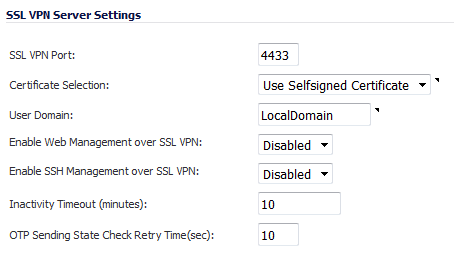

- SONICWALL SSL VPN CLIENT NOT GETTING GATEWAY IP HOW TO
- SONICWALL SSL VPN CLIENT NOT GETTING GATEWAY IP FULL
- SONICWALL SSL VPN CLIENT NOT GETTING GATEWAY IP PLUS
- SONICWALL SSL VPN CLIENT NOT GETTING GATEWAY IP SERIES
(Only the remote client initiates phase I, but either side can identify the need for a phase II renewal of keys if the Security Gateway identifies the need, the Security Gateway initiates the connection.) IKE over TCP solves the fragmentation problem of long packets, but in phase II there are times when the Security Gateway needs to initiate the connection to the remote client. Why not use IKE over TCP again, as in phase I? The NAT device in front of the remote client drops the packet that has no UDP header (containing port information). This can lead to large UDP packets which are once again fragmented by the remote client's OS before sending.
SONICWALL SSL VPN CLIENT NOT GETTING GATEWAY IP SERIES
Remote access clients negotiate methods for encryption and integrity via a series of proposals, and need to negotiate all possible combinations with the Security Gateway. During IKE phase IIĪ remote access client does not have a policy regarding methods of encryption and integrity.
SONICWALL SSL VPN CLIENT NOT GETTING GATEWAY IP FULL
A full TCP session is opened between the peers for the IKE negotiation during phase I. TCP packets are not fragmented in the IP header of a TCP packet, the DF flag ("do not fragment") is turned on. The IKE negotiation is performed using TCP packets. IKE over TCP solves the problem of large UDP packets created during IKE phase I. Note - If the VPN peers authenticate each other using pre-shared secrets, large UDP packets are not created however, certificates are more secure, and thus recommended. If the certificate or Certificate Revocation List (CRL) is long, large UDP packets result, which are then fragmented by the operating system of the remote client. One way of authenticating is through the use of certificates. During IKE phase I, the remote access client and Security Gateway attempt to authenticate each other. To understand why large UDP packets arise, we need to take a closer look at the first phase of IKE. When the second fragment arrives, the NATing device cannot translate the port information because the second packet does not contain a UDP header the packet is dropped. When the first fragment arrives, the NAT device successfully translates the address information in the IP header, and port information in the UDP header and forwards the packet.
SONICWALL SSL VPN CLIENT NOT GETTING GATEWAY IP HOW TO
The NATing device does not know how to wait for all the fragments, reassemble and NAT them. The second fragment consists of only the IP header and the second data fragment.

SONICWALL SSL VPN CLIENT NOT GETTING GATEWAY IP PLUS
The first fragment consists of the IP header plus the UDP header and some portion of the data. In Figure 31‑1, the UDP packet is too long so the remote client fragments the packet. Hide NAT not only changes the IP header but also the port information contained in the UDP header. Problems arise when the remote access client is behind a hide NAT device that does not support this kind of packet fragmentation: If the resulting packets are greater than the MTU, the packets are fragmented at the Data Link layer of the Operating System's TCP/IP stack. When a remote access client attempts to create a VPN tunnel with its peer Security Gateway, the IKE or IPsec packets may be larger than the Maximum Transmission Unit (MTU) value. NAT related issues arise with hide NAT devices that do not support packet fragmentation. For more information on Split DNS see: Remote Access Advanced Configuration. Other issues, such as Domain Name Resolution involving DNS servers found on an internal network protected by a Security Gateway, are resolved with Split DNS. Routing issues of this sort are resolved using Office mode. Other connectivity issues can arise, for example when a remote client receives an IP address that matches an IP on the internal network. IPsec Path Maximum Transmission Unit (IPsec PMTU)Ĭheck Point resolves port filtering issues with Visitor Mode (formally: TCP Tunneling).Issues involving service/port filtering on the enforcement deviceĬheck Point resolves NAT related connectivity issues with a number of features:.Issues involving NAT devices that do not support fragmentation.Under these conditions, a number of connectivity issues can arise: During the morning they may be located within the network of a partner company, the following evening connected to a hotel LAN or behind some type of enforcement or NATing device. Remote clients are, by their nature, mobile. While there are a few connectivity issues regarding VPN between Security Gateways, remote access clients present a special challenge. The Need for Connectivity Resolution FeaturesĬheck Point Solution for Connectivity Issues Resolving Connectivity Issues In This Section:


 0 kommentar(er)
0 kommentar(er)
